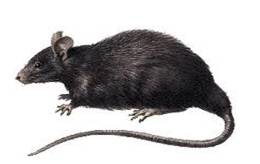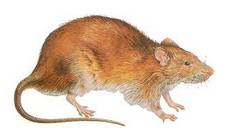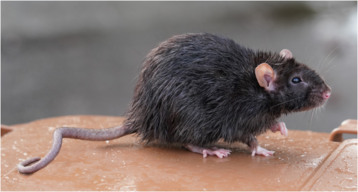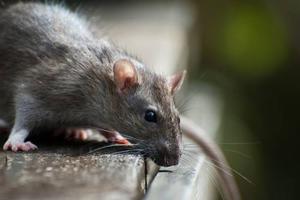|
Rat Removal Rats are an especially big problem for thousands of property owners throughout the Central Florida area. If you have rats causing problems on your property please contact Custom Pest Solutions for more information on how we can provide safe, humane, reliable, and effective rat removal, trapping, control, and exclusion services. Rats are the most successful species on the planet besides humans. Anywhere you find humans, you will find rats. They thrive in most environments where food and shelter are available; be it forested areas, suburban, or city areas. They will construct nests for shelter that can be found in and around homes, warehouses, office buildings, barns, cellars, sewers, garbage dumps, and other areas that provide ample food. Once in a human structure, rats are very destructive and quickly become a nuisance animal to both homeowners and business owners. They are responsible for millions of dollars’ worth of damage each year. No neighborhood is immune and removing rats as quickly as possible is critical to preventing extensive damage. Since rats communicate via pheromones by leaving and following scent trails, if you have one rat, you can be sure that others will follow. Rats will chew holes into different parts of your home or business, or they will take advantage of existing holes due to constructions gaps to gain access into your property. Its body has a shape that has evolved to fit through very tight spaces. Once inside, they will chew electrical wires, ducts, and pipes, create a toxic environment by defecating and urinating within the walls and cause extensive damage to your attic insulation. They can decrease your property’s value when they go unchecked and can create a real potential fire hazard. It is estimated that rodents are responsible for 20 to 25 percent of all fires of unknown causes because of their propensity for chewing electrical wiring and gas lines. Rodent incisors, the two front top and the two front bottom teeth, constantly grow throughout their lives. This ensures that their teeth never wear down from constantly gnawing on hard objects. With these teeth they will also chew through water pipes causing substantial damage that can occur either over time, or as one big "flood." When damage is slow, a small amount of water will continuously seep into spaces within the walls, causing wooden beams to rot and the buildup of toxic mold. Drop by drop, the damage can accumulate over weeks into a problem that can cost thousands of dollars to fix. In other cases, rats can chew through water pipes that are already weak and worn out. Because the pipe is already fragile, the rodent damage can cause the pipe to burst, with large amounts of water loss occurring quickly. In Florida we have 3 main types of rats: the Roof Rat, the Norway Rat, and the Wood Rat. Roof Rat
The Roof Rat, also known as the Palm Rat, Fruit Rat, Citrus Rat, and Black Rat, is the most common type of rat found in Florida. They are climbers and often nest up in trees near the roof and will be the rat most often found in attic spaces, voids along the roof line, and in ceilings. They have big eyes and ears and their fur is smooth and usually black or dark brown. They have long tails that are longer than the combined head and body and can typically grow between 7 to 10 inches in length. Including its tail, an adult Roof Rat can grow up to 16 inches in total length. Their bodies are usually smaller and sleeker than Norway Rats. You can sometimes identify their presence by the grease marks they leave along surfaces. For the most part, they are vegetarian, although they will eat almost anything that is available. Their droppings are about ½ inch long with pointed ends, making them smaller and sharper looking than Norway Rat droppings. These rats can produce as many as 40 offspring within their lifetime, and they tend to live about two years.
Norway Rat
The Norway Rat or brown rat is a burrowing rat that is most often found outside, although they will venture into human structures such as structural foundations, walls, and crawl spaces in search of food. They also thrive around plants, bushes, shrubs, and yard debris and in areas where garbage is not properly stored. Their fur is usually shaggy and brown or grey. They have scale covered tails that are shorter than their bodies. Norway Rats can reach lengths of up to 17 inches including its tail. Their ears are also covered in scales. Wood Rat
The Wood Rat is not as common as the Roof Rat or the Norway Rat, but it is found in northern parts of Florida. Wood rats are nest builders that use plant material such as branches, twigs, sticks, and other available debris for their nests. They are also known as “packrats” because they accumulate food and debris on or near their dens. They often get into everything from attics to car engines, stealing small items, damaging electrical wiring, and creating a noisy mess while foraging for food. The Wood Rat is about the same size as the Norway Rat but is easily distinguishable by its long, soft, fine fur that ranges from black or grey to brown in color and its furry tail instead of a scaly tail. It looks somewhat like hamsters with large ears and long tail. Regardless of the type of rat, you do not want any of them inside your property as they will quickly and easily become a nuisance as well as a very serious health hazard to the occupants inside.  Diseases From Rats
Rats are known for spreading serious diseases to humans and other animals. These diseases can be transmitted through the air, their droppings and by scratches and/or bites. The more prevalent rat diseases are the following: Leptospirosis- A bacterial disease that rats carry without showing any symptoms but that can be fatal to humans when they come in contact with a contaminated rat’s feces or urine. The symptoms in humans include headache, fever, vomiting, muscle aches, and rash. Histoplasmosis-A potentially fatal respiratory disease which humans can contract from rat droppings after fungal spores grow on the rat feces and become airborne. The symptoms include fever, chills headache, muscle aches, cough and chest discomfort. Salmonellosis- A bacterial illness which rats can carry that spreads to humans through contact with rat droppings and urine. In people, salmonella will cause gastrointestinal problems such as fever, diarrhea, and stomach cramps. Adults will usually recover without serious long-term problems, but in some cases, salmonella will enter the bloodstream and then spread throughout the whole body. Rat-bite fever- A potentially fatal illness caused by infected rats or their contaminated feces. Symptoms of this illness include fever, vomiting, muscle aches, headaches, and rashes. The amount of diseases rats can carry is one main reason rat removal is always a necessity. If you think you have rats on your property, give us a call so we can help you with your rat problem.
Our Process For Rat Removal
Our priority when we first arrive on your property is to perform a thorough inspection to determine the type of rat infestation and where the entry points are that they are using to gain entry inside your home or business. Locating all the entry points makes it much easier to not only get rid of the rats but also to keep them out in the future. We will also determine how much damage the rats have caused by searching for nesting and feeding areas . Each situation is different therefore each situation must be carefully inspected so that we can develop a custom rat removal solution to fit your needs. We then start the rat removal process. Our trained technicians regularly check and monitor the property until we are satisfied all removed have been removed from inside. Our next step is to close the entry points and repair all holes created by the rats to keep them out in the future. We offer remediation services as well as full attic restorations to clean up the mess they make and remove any soiled insulation, rat droppings, and urine that may be in the attic. We also recommend fogging the attic with an antimicrobial disinfectant to kill any remaining bacteria so that the area is safe for people to enter again. We will also deodorizer the area to remove any pheromones left behind that will attract more rats into your attic in the future. Through years of experience, we have developed specialized tactics for dealing with rats. We use only the latest and most up to date equipment and techniques to take care of your problem.
How Can I Tell If I Have Rats at Home? Rat Droppings are one of the first signs of an infestation. Typically, you find droppings concentrated along your baseboards or in areas where you store food, such as in your pantry or cabinets.
Depending on the severity of the problem, you may frequently hear scratching or scurrying noises. You will typically hear these sounds in your walls, along your floor, in your attic, or on your roof. As nocturnal creatures, rats are most active after dark so you may not necessarily hear any noises during the day.
Rats are covered with a layer of grease and as they crawl out of holes or run along your baseboards, they may leave behind a greasy mark.
Rats can cause a lot of property damage. As their teeth grow, they will gnaw on wood and plastic, damaging baseboards and electrical wires.
Can I get rid of rats without professional help? We have traveled to many properties where the property owners have tried many rat removal methods that have failed. Rats will not respond to repellents, mothballs, ammonia, strobe lights, or loud music. Rats will sense danger and adapt by steering clear of you and the traps set for them. They can become aggressive when threatened and bite or scratch. Using chemicals or poisons incorrectly can put humans and pets in a dangerous situation. While you may be successful at eliminating part of your rat problem, it is much harder to get rid of every rat that has gotten into your house or business and then even harder yet to not have rats return. |
|
|




